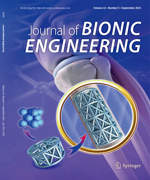|
|
Hierarchical Voronoi Structure Inspired by Cat Paw Pads Substantially
Enhances Landing Impact Energy Dissipation
Da Lu, Baoqing Pei, Yangyang Xu, Mengyuan Hu, Shijia Zhang, Le Zhang, Xin Huang, Yangwei Wang & Xueqing Wu
Journal of Bionic Engineering. 2024, 21 (4):
1847-1861.
DOI: 10.1007/s42235-024-00531-5
When a human lands from a high drop, there is a high risk of serious injury to the lower limbs. On the other hand, cats
can withstand jumps and falls from heights without being fatally wounded, largely due to their impact-resistant paw pads.
The aim of the present study was to investigate the biomechanism of impact resistance in cat paw pads, propose an optimal
hierarchical Voronoi structure inspired by the paw pads, and apply the structure to bionic cushioning shoes to reduce the
impact force of landing for humans. The microstructure of cat paw pads was observed via tissue section staining, and a
simulation model was reconstructed based on CT to verify and optimize the structural cushioning capacity. The distribu�tion pattern, wall thickness of compartments, thickness ratio of epidermis and dermis, and number of compartments in
the model were changed and simulated to achieve an optimal composed structure. A bionic sole was 3D-printed, and its
performance was evaluated via compression test and a jumping-landing experiment. The results show that cat paw pads
are a spherical cap structure, divided from the outside to the inside into the epidermis, dermis, and compartments, each
with different cushioning capacities. A finite element simulation of different cushioning structures was conducted in a
cylinder with a diameter of 20 mm and a height of 10 mm, featuring a three-layer structure. The optimal configuration of
the three layers should have a uniform distribution with 0.3–0.5 mm wall thickness, a 1:1–2 thickness ratio of epidermis
and dermis, and 100–150 compartments. A bionic sole with an optimized structure can reduce the peak impact force and
delay the peak arrival time. Its energy absorption rate is about 4 times that of standard sole. When jumping 80, 100, and
120 cm, the normalized ground reaction force is also reduced by 8.7%, 12.6% and 15.1% compared with standard shoes.
This study provides theoretical and technical support for effective protection against human lower limb landing injuries.
Related Articles |
Metrics
|

 Table of Content
Table of Content
 Table of Content
Table of Content